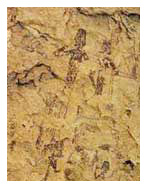The historic treasure of the Spanish cave paintings
Seventeen Spanish rock caves of the Cantabrian fringe last week received the deserved recognition of being declared a World Heritage Site by UNESCO. This rich heritage is hidden is dark and sheltered caves in Cantabria, the Basque Country and Asturias. Protected from the erosive action of wind or rain, these witnesses millennia of human history are one of the most impressive and beautiful testimony.

Photography by A.M. Kuchling
Many of these caves can be visited and essential if you travel north of the Iberian Peninsula. Much less known to the Altamira Cave, at least so far, these caves retain some of its authenticity to receive visits only small groups and tightly controlled, so as not to affect the conservation of paintings.
The caves now spend part of the world’s greatest historical treasures are those of Chufín, Hornos de la Peña, The Castle, The Pasiega, coins, Pendo, La Garma and Covalanas in Cantabria, the Basque Santimamiñe (Kortezubi ) Ekain (Zestoa) and Altxerri (Aia), and Tito Bustillo in Asturias, La Peña de Candamo Llanín and Pinal.
The nomination of the caves was promoted by the Governments of the Basque Country, Cantabria and Asturias, as part of the declaration of Altamira, and that thus the proposal would have more chance of being accepted by UNESCO. The proposal was based on the number and density of decorated caves to be found in this region of northern Spain, good condition, its rich iconography, the diversity of techniques and styles that meet and length of some paintings converting the Cantabrian coast in one of the places where the birth took place rock art.
With this recognition, the caves are made at the same level as the Cave of Altamira, which was declared a World Heritage Site in 1985.
Covalanas Cave (Branches):
Covalanas Cave in Cantabria, is actually a very rich and interesting experience. Was used as a dwelling place for at least the past 45,000 years and keeps a pictorial legacy to us about these prehistoric civilizations, so distant, yet so close in concepts, needs and interests.

To visit it is necessary to arrange the visit by phone, and generally acts as a guide for archaeologists working in the field and study of the paintings, providing valuable information and first hand about the life and culture of the early settlers of the Peninsula. The visit lasts about 50 minutes. It is done in groups of 6 to 10, depending on the season.
Most representations of the cave is the deepest focus of one of its two galleries, a space of about 12 meters long. In total, there are 22 figures of which 18 are deer, animal characteristic of the decorated caves in Cantabria, a horse, a reindeer (animal rarely in the region of Cantabria), a uro and difficult to identify an animal. It is interesting to see how the painters used the relief of the walls of the cave to give volume to their figures.
The Spanish cave paintings are a different way of sightseeing!
Leave a Reply
You must be logged in to post a comment.
Recent Comments